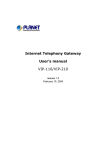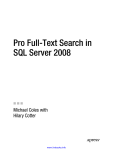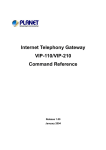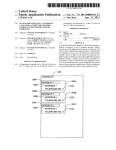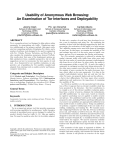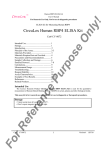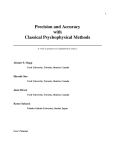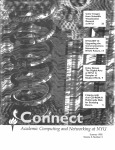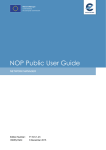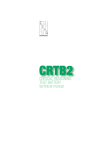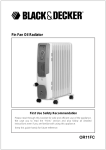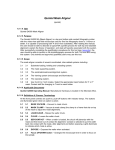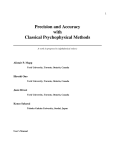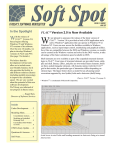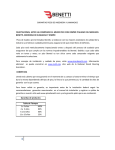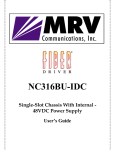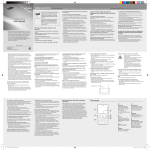Download Some guidelines for student assignment writing
Transcript
Standards for the Presentation of Written Assignments Dan Eaves and John Hurst Introduction The appearance of any written submission has an immediate effect on its reader. As a student, a little care in presentation may earn several marks. In business and other critical areas of your life, it may mean the difference between success and failure. To assist you in developing good habits for written submissions, we have prepared the following guidelines which we expect you to follow for all written assignments. Note, however, that these are the Faculty of Information Technology’s standards, and other departments and organisations may follow different ones. One of the most frequently voiced complaints by employers of recent graduates from tertiary institutions is that most of them seem incapable of writing an acceptable English sentence. It is our devout expectation that this will not be said of Monash graduates in computing. To be successful in the world of commercial data processing, mastery of the syntax of English is as important as mastery of the syntax of a programming language. You may expect your work to be rejected, marked down, or even failed, if it is not in acceptable English. Work at the University is, by definition, at a higher level than high school work. Certain habits which might have been tolerated in school are unacceptable here. In particular, wholesale ‘piracy’ – the use of large amounts of material copied from published sources without attribution – must be avoided. If it is not, the result may be a mark of ‘0’, as if the assignment had not been turned in at all. 1 1.1 Physical Presentation Binding All assignments should be bound firmly into a cover, such as a Manila folder, plastic folder, ring binder, etc.. Please do not use envelope folders or submit loose sheets. While program listings may be placed in such covers, remember that it should be possible to read every page without undoing any fastenings. 1.2 Identification Every assignment must be clearly identified. The following details must appear both on the cover and on the title page of all assignments: Name Student number Assignment title Subject code Subject name Lecturer Tutor (if appropriate) Due date for submission 1 1.3 Legibility Standards While assignments may be handwritten, typed or word processed, word processing is strongly recommended. If handwritten, submissions must be in pen and must be legible. If produced on a matrix printer, they must be in upper and lower case (excepting program listings), and printed using a good ribbon. Use a laser printer where possible. Assignments with illegible handwriting or printing will not be marked. All material must be ’double spaced’: leave a half or full line between each line of text. Use only one side of the paper. Do not use red or green ink. Do not draw in margins. Do not decorate your title page. This is not high school, and the sooner such absurd habits are dropped, the better. 1.4 Contents 1.4.1 Title Page A title page must be present, showing the same information which appears on the cover (see 1.2 above). 1.4.2 Table of Contents Where relevant, a table of contents should appear immediately following the title page. This should list each section (and appendices, if present) with their page numbers. 1.4.3 Supplementary Material Tables, print outs, etc. which are referred to in the text and need to be included in the submission should be included as appendices rather than disrupt the flow of the narrative. However, tables and figures which take up a page or less should be placed in the body of the text. 1.5 Structure All essays and reports should have a clear structure. This may vary according to the topic, but the following elements will usually be present. An introduction A literature overview The main body of the paper/submission Conclusions Appendices (if any) References 1.6 Paragraph Numbering and Indention For some types of material, such as this Standard, numbered paragraphs, perhaps with differing indentations, are appropriate. If the paper is narrative in structure, however, such a physical make-up detracts from the readability of your work, and should be minimised. If numbered paragraphs and multiple levels of indentation are used, try to limit them to no more than four levels. In any case, the outer margins should be set to 2-3 cm. on both left and right. 2 1.7 Justification When using a word processor, you should avoid right justification unless true proportional spacing is available. Research indicates that right justified text is harder to read where the justification takes the form of inserting multiple spaces between words. True proportional spacing either inserts small amounts of extra space between letters, gives different letters different widths, or both. 1.8 Desk Top Publishing Use of desk top publishing (DTP) and laser printers is strongly encouraged. Laser printers are available in a number of locations. Where desk top publishing is used, no text should be underscored. Underscoring is actually an instruction to the (hypothetical human) printer to set the underscored material in italic type. As italic type is available on all DTP systems, it should be used instead. If using DTP, limit the number of fonts used. A useful guideline is to use a serif font (Times, Bookman, etc.) for the body of the paper. Use a sanserif font (like Helvetica, Geneva or Ariel) for headings. Use Courier (the fixed space typewriter font) for program listings contained in the paper. This Standard is set in Times, with the examples in Helvetica. 2 Logistics This section provides a brief introduction to logistics issues involved in the creation and submission of written assignments. 2.1 Personal Computer Ownership If you own a microcomputer and printer, your chances of success at Monash are considerably higher than they are if you do not. One of the reasons for this is that you will benefit from being able to use a word processor for the preparation of your assignments. While both PCs and software are available for use at Monash, relying on these facilities has at least two distinct disadvantages. Because of the degree of theft and vandalism, access to hardware is highly restricted, especially at those times of the academic year when you need it most. In addition, the particular configurations of the machines in labs may mean that you are unable to use the software products you require. An acceptable PC and printer can be purchased new for less than $2,000 from a number of sources, including the Monash Computer Shop (branches at all campuses). For the lowest prices (at a certain risk) check in the Green Guide published in the Thursday Age newspaper. As of the date of writing (1998), the minimum PC you should consider purchasing is an pentium-based machine, 133MHz or faster, with a hard disk of at least 500Mb and four megabytes of RAM. Such a machine will have a useful life of three to four years, and last through your undergraduate career. 2.2 Sources of Cheap Software Public domain and shareware software is widely distributed for the cost of the disk. Public domain software is free. Shareware is distributed free, but you must register and pay the publisher if you elect to use it after your free aW. Shareware prices are usually between 10-20% of the cost of commercial packages. Academic editions are available for a number of commercial products. These are copies of the products, complete with all manuals, for sale only to students. Their price is between 25 and 33% of the retail 3 price. Most academic editions are for sale through the Monash Computer Shop, which also provides a catalogue. In some cases, site licences for particular products have been purchased by Monash. In such cases, copies of the software are freely available through the Monash University community. Note that the Vet virus protection program is available through such a site licence, and may be readily used without reference to any manual. We recommend the following shareware products for the preparation of reports and papers: PC-Write (full word processor), Galaxy Lite (simple word processor) and PC-Outline (outliner and simple word processor). PC-Outline is especially recommended. We strongly discourage the use of stolen software, just as we discourage the theft of books from the Library. Shareware products are cheap enough (less than $100, usually). 2.3 Turning Work in Early (No Fault Submission) In most cases, you will be asked to turn you work in to your tutor or lecturer, by a specific date. If you follow this procedure, and your work is unacceptable because of bad English, you may not have either the opportunity or the time to rewrite your work and resubmit it. Most tutors and lecturers are willing to accept copies of assignments in advance to check for their acceptability mechanically. That is, they will not mark it in advance, but will simply let you know if it is acceptable in terms of its mechanics. 2.4 Language and Learning Services For students who have difficulty in preparing written assignments, some assistance is available through Language and Learning Services. The unit has offices on all campuses. 2.5 Recognising and Solving Your Own Problems One of the differences between tertiary study and high school is the increase in the freedom you have to make errors and then suffer the consequences. If you submit unacceptable work, we will fail it. If you do not recognise your problems and solve them, we will continue to fail your work. The responsibility for recognising areas of difficulty and resolving them is yours. While we have made facilities like Language and Learning Services available, and have provided Standards such as this one, no one is forced to make use of them. 3 Citations Citations are the references to others’ work which you have used. They are placed in the body of your paper. Their purpose is to provide the reader with an intellectual ‘audit trail’ which can be followed back from your efforts to the sources you used. For this reason, citations and a matching list of references are necessary where a particular published or unpublished source has provided ideas you have used, even if you have not used a direct quotation. However, you do not need to cite sources for ideas which are common knowledge in the field covered by your work. For example, if you remark that the relational data base model considers files as two dimensional tables, there is no need to provide a citation. On the other hand, you could cite Codd’s original papers on the subject. Whether or not to cite in such circumstances is a matter of personal preference 4 but, when in doubt, cite. (The fact that a citation will allow you to bring to your tutor’s attention the fact that you have actually read – or at least heard of – Codd’s papers may be worth considering ...) You may be successful in submitting papers without citations, with citations in conflicting formats, or full of material taken word for word from published work and included without inverted commas. Or, such practices may result in a paper being rejected or, in the case of plagiarism, failed. We find it highly frustrating to have to regularly reject or fail papers because their authors were foolish enough not to believe us. We only repeat these warnings with such a boring regularity because so many otherwise intelligent people submit work embodying practices they should have grown out of when they left high school. 3.1 Overview of Citations There are a number of different methods of citing sources, listing references, using footnotes, and setting off quotations. The FIT standard given here is one commonly used in the scientific literature. The basic principle: Where you are citing a reference in the body of the paper, insert the author’s surname and the date of publication of the work: (Steele 1991). The list of references at the end of the paper is arranged by author, and sub arranged by date. The reader interested in checking the reference can easily find it in the references. Where you are citing a book, rather than a paper, you may feel that the author-date combination is not sufficient to direct the reader to your source. If you feel this way you may add the page number(s) after the date: (Steele 1991: 123). With ‘secondary’ quotations (you are quoting a source quoted by another source), the citation should be to the original publication. In the references, enter the information describing the original source, followed by ‘in’ and the details of the source where you found the quotation. See Section 6.3.2 below for examples. Always use just the surname(s) of the author(s). If the same author will be cited more than once, and the papers were published in the same year, add a letter to each date to distinguish between them. At times it is difficult or impossible to find the name of the individual(s) who wrote the material being cited. A common case is a newspaper story with no byline. While several rules which will cover many such cases are given below, they are not comprehensive. In other circumstances, insert whatever information you have in the citation within square brackets. The square brackets are a ‘code’ used to indicate that the information within them has been ‘imported’ by you, and is not to be found in the actual printed source. 3.2 Citations with One Author At the appropriate point in the text, the surname of the author and the year of publication should be inserted. Use a single initial to distinguish between authors with the same names: In a study of national differences (Milgram 1988), the ... A study of corporate behaviour (H. Smith 1992) showed ... In a recent examination of GUI standards (A. Smith 1992), there were ... Where the name of the author appears in your text, simply add the date after the name: Milgram (1968) showed in his study... Jones and Ince (1992) argue that ... 5 3.3 Citations with Two or Three Authors Always cite all names in the text: There are many problems with this approach (Amidon and Carey 1972). It was demonstrated by Amidon and Carey (1972) that ... 3.4 Citations with More than Three Authors If there are more than three authors, all names should be cited the first time they are cited. Thereafter, it is only necessary to cite the name of the first author and insert et al. after it. Et al. should be in italics and should include the full stop. Farley, Brown, Simmons and Heath (1972) observed.. Thereafter: Farley et al. (1972) observed ... There is not universal agreement on the approach required (Farley et al. 1972). 3.5 Citations with No Authors and Corporation Names In the cases where there is no author’s name printed at the head of the paper cited, there are three common situations: 3.5.1 Author Is Known but Not Given Formally Cite the author’s name in square brackets: There was much resistance to this idea in industry ([Canning] 1979). In the list of references, the name is also shown in square brackets, but these brackets do not affect the filing. 3.5.2 The Publisher Considered as the Author Give the publisher’s name in round brackets: Traditionally, this approach has not been popular (Datapro 1985). In their survey of industry trends (Chantico 1992), a drift towards... This can be seen from the manual for Windows 3.1 (Microsoft 1992). 3.5.3 The Organisation Is the Author In this case, common abbreviations may be used, in round brackets: There is an Australian guide to ethics (A.C.S. 1985). In the syllabus for the subject (R.M.1-T 1986), there is little coverage... As can be seen from the manual (I.B.M. 1988), the changes in the upgrade were... 6 3.6 Authors with Identical Surnames When referring to authors with the same surname, initials should be included even if the date of publication is not the same: While some argue one way (K. Smith 1983), conflicting opinions are easy to find in the literature (L. Smith 1975). 3.7 Multiple Citations of the Same Author When citing two or more works by the same author in the same year, lower case letters should be used after the year of publication: (Smith 1992a) (Smith 1992b) 3.8 Citations of Specific Part of Source When citing papers of a normal size (¡20 pages or so) there is no need to put page numbers in citations. For long papers or books, you may wish to add them. While an example is given below showing how to cite an entire chapter, page citations are preferred. (Milgram 1968, 24-27) (Rosengren 1974, ch. 6) 3.9 Citing Unpublished Materials Information which results from telephone calls, interviews and correspondence must be cited when it is used. Follow the rules given above in creating the citation in the text of your paper. That is, give the name of the person who supplied the information. Note that the year is still necessary: Some industry leaders disagree (Smith 1993). In the list of references, the matching entry should include the phrase: [Personal communication] 3.9.1 Multiple Citations Arrange multiple citations by author or date, separated with a semicolon. There is wide agreement on this (Arnott 1991; O’Donnell 1989; Perrera 1992). There is wide agreement on this (O’Donnell 1989; Arnott 1991; Perrera 1992). 7 3.10 Citing Software and Manuals Usually, the publisher of the software is considered to be both the author and the publisher. When showing the publisher as author, include the full name in round brackets as shown in Section 3.5 above. The citation in the text, e.g., (Pioneer Software 1992) should have a matching reference in the list of references, e.g., (Pioneer Software) (1 992). Q+E Database Editor User’s Guide. Raleigh, N.C.: Pioneer Software. 4 Quotations and Para-Phrases A quotation is a word for word transcription of text originally published elsewhere. A paraphrase is a rewritten extract from another source. Direct quotations must appear in inverted commas and end with a citation. No inverted commas are used with paraphrases, but the citation at the end is still necessary. If you use more than five words taken directly and word for word from a published source, and do not indicate that the material is a quotation, you are guilty of plagiarism. This is the case even when you cite the source in the body of your text, or in your references, or both. Plagiarism will result in a mark of 0. 4.1 Embedded and Block Quotations If a quote is less than four lines in length, insert it within your text within single inverted commas. Quotes longer than three lines in length should be set off from the body of the text in a separate block, indented from the left and right margins and single spaced. Do not use inverted commas around block quotations. When using the block format, place the citation in the line below the last line of the quote. 4.2 Editing Quotations Frequently you will need to quote only sections from a passage in a source. You should indicate deletions and additions using the following rules. 4.2.1 Deletionsfrom a Sentence If you leave words out of a sentence in a quotation, mark the position with three full stops. Follow this practice for deletions from the beginning, the middle or the end of a sentence. ’Assumptions may be based on... several criteria.’ ’...after merging the files.’ ’Much data may be lost...’ 4.2.2 Deletion of Full Sentences Where you are quoting several sentences from a passage, and leave out one or more sentences, insert four full stops at the end of the sentence before the missing text. ’We came.... We conquered.’ 8 4.2.3 Inserted Material Often an edited sentence will not make sense unless one or more words are inserted. Such words should be enclosed in square brackets. ’[They] rejected our findings.’ ’We then [decided] to use a sparse array.’ 4.3 Paraphrases When you rewrite a published source in your own words you are paraphrasing. This is a normal practice in academic writing, and should be indicated with a citation. When you are providing an extensive paraphrase, it is standard practice to begin the section with a phrase which indicates the source. Having provided such an attribution, there is no need to clutter up your text with repeated citations to the same source. Some of the phrases which are frequently used to introduce extensive paraphrases are: The following discussion is based on Bloggs (1987). The argument which follows is largely based on Bloggs (1987). The section which follows owes much to the seminal work of Bloggs (1987). 5 Footnotes Footnotes are only used when you wish to elaborate on an idea in the text, but doing so within the text would detract from the narrative flow. Footnotes are necessary digressions. For most work in the FIT, footnotes should not be necessary. Insert the footnote number at the end of the sentence it relates to1 . If you are unable to place the number a half line above the text, place it in brackets: (1). Footnotes may appear at the end of the text (but before the references) or at the bottom of the page. If they are placed at the bottom of the page, set them off from the body of the text with a solid line extending at least a quarter of the way across the page. In either case, notes should be single spaced. 6 References, Works Cited or Bibliography The reference list should appear at the end of the paper starting on a new page. It should contain only the material directly cited in the text. Reference material should be listed accurately to allow the reader to retrieve the material if necessary. The list should be in alphabetic order by author, and subfiled by date of publication where necessary. The list may be given any of the names noted above. 6.1 Reference Mechanics 6. 1. 1 Indentation 1 This is a footnote. It works properly when this document is typeset by LaTeX, but is treated differently by LaTeX2HTML, and so the web version does not show the right thing! 9 The first line of a citation should begin at the margin and have successive lines indented. The indentation helps the reader find the work of interest. Xxxxxx, X. (9999). Xxx X= xxxxxx xx xxxx xxxxxxx xxu xxx xxxx.Xxxxxxxxx: Xxx Xxxxxxxx. 6.1.1 ‘Imported’ Information Where you know a fact which should appear in the citation, but which is not actually printed in the document itself, supply it in square brackets: []. This is especially useful when citing manufacturers’ catalogues or fliers, handouts at conferences or courses, and other ephemeral materials. 6.1.2 Underscores, Italics and Bold Face In citations, words are underscored where they would be in italics when the paper is printed. Underscoring is actually an instruction to the printer (a person, not a machine). If your paper will be printed on a machine with italics available, do not use underscoring, but use italics instead. When using a word processor with bolding and underscoring available, but not italics, prefer the bold face. 6.1.3 Abbreviations c. or ca. (L. circa) about (ca.1978) cf. (confer) compare – ‘see’ is more common ch., chs. chapter, chapters e.g. (L. exempli gratia) for example ed., eds. edited by, edition, editor, editors f., ff. and following page/pages. Not normally needed F. French i.e. (L. id est) that is ibid. (L. ibidem) in the same place, just cited L. Latin n.d. no date provided n.p. no place provided op. cit. (L. opere citato) in the place cited (above) p-, pp-, ppspage, pages rev. revised, revision tr., trans. translated by V., Vol., vols. volume, volumes Some dictionaries (e.g. The Macquarie Dictionary) include abbreviations in their listings. 6.1.4 Capitalisation of Titles There are essentially two patterns of capitalisation for titles of books and journal articles. Either capitalise only the first word in titles, or capitalise all words except articles and (short) prepositions. While either is correct, you must pick one and follow it in all cases. Note that, if you elect the first method and the first word in the title is an article, you still only capitalise the first word (the article). Follow these rules in your tables of contents as well. 10 Simon, H.A. (1981). The Sciences of the Artificial 2nd ed. Cambridge, Mass.: The MIT Pr. Simon, H.A. (1981). The sciences of the artificial 2nd ed. Cambridge, Mass.: The MIT Pr. 6.2 Monographs A ‘monograph’ is a book on a specific subject. It is not an anthology or collection of papers. 6.2.1 Monograph References The information needed for the reference list should be printed either on the title page of the monograph or on the back of it. If this is not the case, and you know the missing fact, put it in its proper place but in square brackets. [N.Y]:McGraw-Hill. The basic format is: Surname, Initials. (date). Title: Subtitle. Edition. Volume. Place: Publisher. Put in up to three joint authors. For four or more authors, enter only the first, followed by et al.. Where there is no author, enter five dashes and a full stop. Then carry on with the citation as if a name had been entered. Note that dashes file before letters! 6.2.2 Monograph Examples —- (1979). Scholarly communication: The report of the national enquiry. Baltimore: Johns Hopkins U. Pr. Braun, E. and MacDonald, S. (1 978). Revolution in miniature: The history and impact of semiconductor electronics, Cambridge: Cambridge U. Pr. Date, C.J. (1986). An introduction to database systems. 4th ed. Reading, Mass.: Addison-Wesley. Fagan, R. (1885). Normal forms and relational database operators. Dodge City, Kansas: Smith & Wesson. Schiller, D. (1 982). Telematics and government. Norwood, N.J.: Ablex. 6.3 Collections These may be collections of papers, anthologies, conference proceedings or the like. 6.3.1 Collection References Details must be provided of both the particular segment being cited and of the work in which it appears. The basic format is: Surname, Initials. (date). ’Title of paper’ in Title of publication, (ed.) Initials Surname of editor. Edition. Place: Publisher, date if differs. Volume, Pages. 11 6.3.2 Examples of Collections Angyal, A. (1940). ‘A logic of systems’ in Systems thinking: selected readings, (ed.) F.E. Emery. Harmondsworth: Penguin, 1969. 17-29. Carbonell, J.G. et al. (1983). ‘The XCALIBUR project: A natural language interface to expert systems’ in Proceedings of the Eighth International Joint Conference on Artificial Intelligence (IJCAI83), (ed.) A. Bundy. Los Altos, Calif.: Kaufmann. Vol. .2, 653-656. Miller, G.A., Galanter, E. and Pribram, K.H. (1960). ‘The formation of plans’in Thinking and reasoning, (eds.) P.C. Wason and P.N. Johnson-Laird. Harmondsworth: Penguin, 1968. 291-306. Schank, R. (1984a). ‘Intelligent advisory systems’in TheAlbusiness: The commercial uses ofartificial intelligence (ed.) P. H. Winston and K.A. Prendergast. Cambridge, Mass.:MIT Press. 133-148. Schank, R. (1984b). ‘Advisory Systems’ in Artificial intelligence applications for business: Proceedings of the NYU Symposium, May, 1983, (ed.) W. Reitman. Norwood, N.J.: Abelex. 235-248. 6.4 Journals A ‘journal’ is any source published regularly. It may be a newspaper, a magazine, or even a book published several times a year. 6.4.1 Journal References Journal articles are cited in much the same manner as collections. The name of the article is placed in inverted commas and the name of the journal is underscored (or printed in italics, or bold face, where available). The volume number, issue number (if any), and pages are given after the journal title. Giving the date of the issue (normally the month) is optional. 6.4.2 Journal Examples —– (1984). ‘Software commands’. Datamation, 30:21 132 (15 December). Clark, C.E. and Wong, M.K. (1985). ‘Verifying conformance to the X.25 standard’. Data Communications, 14:4 153-160 (April). Damerau, F.J. (1985). ‘Problems and some solutions in customization of natural language database front ends’. ACM Trans. Office Info. Sys., 3:2 165-184 (April). Naur, P. (1975). ‘Programming languages, natural languages, and mathematics’. Communications of the ACM, 18:12 676-682 (December). 6.5 6.5.1 Ephemeral Materials Ephemeral Material References ‘Ephemeral materials’ are defined as being of no lasting value. However, they may be quite important when working in areas such as computing and information science, where the rate of change is so high that many books and articles are out of date before they are published. 12 Manufacturers’ handouts and fliers, materials distributed in presentations and conferences, and information from personal letters or telephone calls may all be thought of as ephemera. As far as possible, they should be listed in your citations. As indicated above, the convention is to use square brackets where you need to include information which you know to be correct but which is not actually printed on the document. The phrase [personal communication] may be used when citing letters, conversations and telephone calls. While not formally necessary, it is useful to give the number of pages of such items. 6.5.2 Examples of References to Ephemera Zylog Inc. (1979).’Z6132 4K x 8 Quasi-Static RAM: Product Specification’. Preliminary ed. (April, 1979). Cupertino, Calif.: Zylog Inc. 7 pages. [Chisholm Institute of Technology Computer Centre]. [(1985)]. ‘Kermit has Arrived’. [Cauffield: The Centre]. 1 page. Redpath, R. (1993). [Personal communication]. 6.6 Computer Software and Manuals The publisher of the software is considered to be the author. Include the full name. Be careful to distinguish between the software itself and the manuals, and insert [computer program] or [user manual] if this is not obvious. Treat the release number as if it were the edition. Microsoft Corp. (1 992). Microsoft Exce/[computer program]. Rel. 4. [Redmond, Wash.]: Microsoft Corp. Microsoft Corp. (1 992). Microsoft Excel User’s Guide. Rel. 4. Vol. 2. [Redmond, Wash.]: Microsoft Corp. Corel Systems Corp. (1988). CorelDraw[user manual]. Rel. 2.Toronto: Corel Systems Corp. 7 Style Hints These are, obviously, not comprehensive. In fact, in certain circumstances some of them may be incorrect! The purpose of this section is just to highlight a few common errors and confusing areas. If you regularly make the sorts of errors discussed in this section, you will probably be understood, but may well also be considered by your readers to be functionally illiterate. If you have problems because English is not your first language, Language and Leaming Services is in the business of trying to make your life easier. 7.1 The Possessive Apostrophe This is the most common grammatical error in technical writing, but the rules are simple: 13 • use ’s when a person owns something ... John’s computer. • ... except where the name of the owning person ends with s, then just use the apostrophe. Jones’ computer. • Organisations are handled like people: Monash’s computer. Darling Downs’ computer. the Department’s computer. the various departments’ concerns. management’s concerns. • Nouns are also handled like people: this week’s work. seven weeks’ work. the idea’s implication. these ideas’ implications. 7.2 Sentence complexity If a sentence contains more than 17 words, or two commas, the reader will probably not understand it on first reading. The previous sentence contains 20 words. This rule should be applied with great flexibility. But use it when drafting your final version as a guide for identifying sentences which should be broken up into several smaller ones. And don’t start a sentence with a conjunction (like the last two sentences of this paragraph)! 7.3 Spelling Out Numbers Small integers should be spelled out, larger ones can be written as digits. The boundary line is not fixed, but as a general rule, anything less than 10 should be spelled out. Avoid writing zero or one as the digits 0 or 1 in text, since they can be mistaken for letters. There are seven full professors at Clayton, three at Caulfield, and zero at Berwick, Peninsula and Gippsland, for a total of 10 in the Faculty as a whole. 7.4 Active and Passive Sentences A passive sentence has its object as its subject. It was decided that we would go to the pub. CASE tools are evaluated in Chapter 2. The system was crashed by my program. Active sentences are always better than passive ones. 14 We decided to go to the pub. Chapter 2 evaluates CASE tools. My program crashed the system. 7.5 I Try not to use ‘I’ in the body of your paper. However, it is appropriate to use ‘I’ in your conclusion, and at other points when you are presenting your own opinions. 7.6 Slang and Informal English Leave them out. This includes the common contractions you use when speaking, e.g., can’t, isn’t, it’s, won’t, lots of, and so on. Written English is not the same as spoken English. 7.7 Commas The most frequent error in the use of commas is to use only one where two, or no comma at all, are needed. That is, when you set off a clause in a sentence, either put commas at either end of the clause or use no commas. Each of the sentences in the paragraph above contains an example of the use of pairs of commas. 7.8 Some Words to Avoid As a matter of standard academic English always prefer: • ‘however’ to ‘though’ • ‘one’ to ‘you’ • ‘much’ or ‘many’ to ‘a lot of’ • ‘which’ to ‘who’ when the reference is to a business, department, Organisation or other collective entity. • almost anything to ‘solution’ when that word is being used as a synonym for ‘hardware’, ‘software’, ‘system’, ‘package’, ‘configuration’, ‘program’, ‘facility’, ‘product’, or some combination of these. 7.9 Parallelisms When writing a list of points which are each an extension of an incomplete sentence immediately preceding the list, each item in the list should have the same grammatical form and, by itself, correctly finish the sentence. For example: Some aspects of concern are: 1. the security of the data, 15 2. the protection of confidentiality, 3. the costs of such measures. Generally speaking, each item of the list should finish with a comma (short items) or semicolon (longer items), except the last, which should finish with a full stop. Not: Some aspects of concern are: 1. the need to protect security 2. Without doubt, confidentiality 3. often these are expensive. 7.10 Verb Tenses in Discussions of the Literature When you are discussing someone’s paper, the tense of the first verb you use commits you for the rest of the discussion as far as tense goes. ‘Smith argues...’ puts you in the present tense, and ‘Smith argued...’ in the past tense, for the remainder of your comments on his work. This means that a following sentence should read, ‘This will cause...’ in the first case and, ’This would cause...’ in the second. 7.11 i.e. and e.g. Use i.e. before a list and e.g. before one or more examples. Both forms are abbreviations and require full stops. They both must be set off by a pair of commas: There are several factors to consider, i.e., the size, weight and volume. Consider the background of the students, e.g., their first language. 7.12 Its and It’s; Their, There and They’re; Affect and Effect Getting these words wrong is usually taken as a sign of ‘functional illiteracy’. You have to get them right. ‘Its’ is an exception in that the possessive does not use the apostrophe. So “it’s” is the abbreviation for ‘it is’ and ‘its’ is the possessive. Grammar: it’s tricky! When we consider its trickiness, it’s true that it’s sometime irrational. Considering its complexity, it’s a wonder that it’s ever learned. If you read every “it’s” as the equivalent “it is”, it’s easy to seen when to use it. ‘There’ is the place, ‘their’ is the possessive and “they’re” is the abbreviation for ‘they are’. In their confusion, they’re going there, rather than coming here. Remember, ‘Affect’is the verb and ‘effect’is the noun. Remember RAVEN! The change had a great effect on the response time. The change will affect the response time. Note that ‘effect’ can be used as a verb, when it means ‘bring about’ or ‘make happen’. This means the RAVEN rule has to be applied with care. It also means that if you use the wrong word, you might be misunderstood! For example, what does this sentence mean? (Taken from an actual newspaper story.) 16 These procedures will effect the legislation. Was the legislation enacted (brought about), or just changed? 7.13 Capitalisation A common error in business and computing writing is the capitalisation of words which should not be capitalised. Perhaps this tendency is due to a desire to capitalise the words in phrases that are used as acronyms. That is, because we use ’DBMS’ to stand for ’data base management system’, we fall into the error of capitalising the words in the abbreviated phrase. WYSIWYG or what you see is what you get. AI or artificial intelligence. KBS or knowledge-based system. KE or knowledge engineering. SDLC or system development life cycle. However, the names of products, companies, departments and the like are always capitalised. MS-DOS or Microsoft Disk Operating System (the proper name of a product). IBM or International Business Machines (the proper name of a company). CSD or Customer Service Department (the proper name of a department). Do not fall into the common error. Capitalise only proper nouns. 7.14 Non-sexist Writing This is not a trivial or token issue. Deeply sexist attitudes are embodied in many of the conventions of written and spoken English, and inevitably reach from there into the ways we think. It is important to recognise these conventions and eliminate them from your writing style. Consciously examining your writing for sexist structures is a good way of learning (or reminding yourself) of how deeply these strange attitudes are embedded in our society. Make use of alternative forms such as ‘s/he’, ‘he or she’ or ‘he/she’. Reversing the order of these to ‘she or he’, ‘she/he’, occasionally also helps! Find an alternative word that identifies to whom you are referring, such as ‘the student will be punished’ rather than ‘he or she will be punished’. Use she as well as he for the generic human reference. You can shift from one form to the other on a section by section or chapter by chapter basis. When referring to a number of people who are taking various roles in your discussion, use she for some and he for others. For example, if you are discussing the relationship between the user and the system developer, use she when referring to one of them, and he when referring to the other. Remember to be consistent, and be careful that you don’t always make the superior of the two people the ‘he’ person! This technique actually has the great advantage of reducing many of the traditional problems of pronoun reference. Review your text carefully for unconscious sexism. Do you seem to assume that all managers are men, or all data processing clerks women? 17 7.15 Tricks for Catching Errors Read the paper out loud to someone. This person doesn’t have to understand the subject. The idea is to hear what you have written and mark problem areas as you go along. Don’t give the paper to someone else to read who knows the subject well. Either they will be afraid of insulting you, and say nothing, or they will say something and you will be insulted. If you have problems with the mechanics of English, or with spelling, find someone who can read your paper and correct the simple errors. Again, it is probably better if this person doesn’t understand what you are writing about, or agrees at the beginning not to criticise the substance of your paper. 18



















